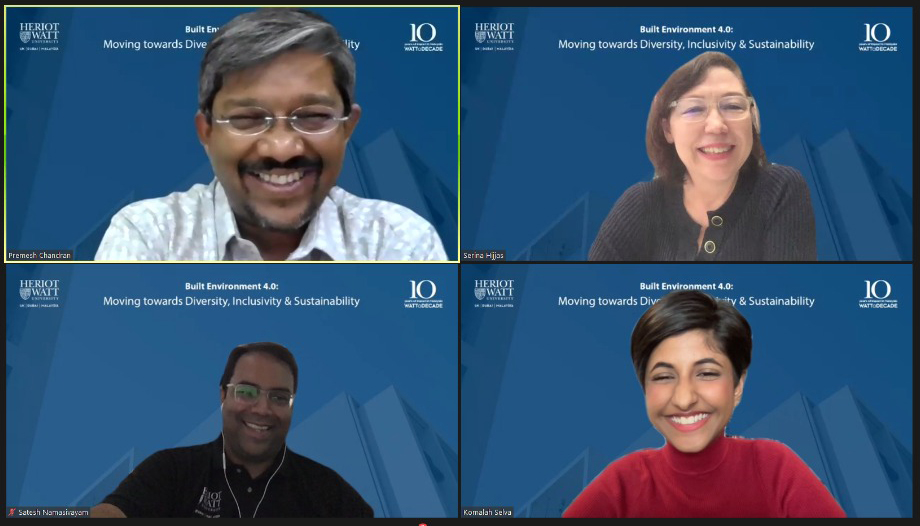Published:

While Malaysia has been making huge strides to narrow the gender gap, women representation in male dominated professions such as the built environment is still low. The Department of Statistics Malaysia (DoSM) reported that women's Labour Force Participation rate (LFPR) for 2020 was 55.3%, lower than neighbouring countries such as Thailand (66.8%) and Singapore (69.7%).
In view of this, Heriot-Watt University Malaysia (HWUM) through its School of Energy, Geoscience, Infrastructure and Society (EGIS), organised a live webinar session, titled ‘Built Environment 4.0: Moving towards Diversity, Inclusivity & Sustainability' on Thursday, 28 April 2022. The webinar aimed to address barriers women face in male-dominated professions in the built industry and to propose solutions to narrow the gender gap as the country moves towards a more equitable, diverse, inclusive, and sustainable nation.
The webinar session featured visionary leaders of the industry including Architect (Dr.) Serina Hijjas (Hijjas Architects and Planners Director and HWUM Honorary Graduate), Professor Ir. Dr. Satesh Namasivayam (Head of HWUM's School of Energy, Geoscience, Infrastructure and Society), and Komalah Selva (HWUM alumni). The panellists raised several interesting points on women's current representation in the built environment landscape, including their low participation rate in schools and workplaces. They also discussed career opportunities and future skills needed for the industry.
Misconceptions of Built Environment Industry
Professor Ir. Dr. Satesh shared that the low participation rate may be due to unconscious bias or stereotyping of the industry. He explained that the general misconception that a career in the built environment industry involves manual labour and/or construction, which is deemed as not suitable or attractive for women.
“The built environment industry has a wealth of career opportunities spanning all areas of the construction and building sector across management and operational roles; all of which are suited for aptly qualified individuals, women, and men alike,” he said.
“I believe we are progressing as we move towards a more developed nation, which thrives on shared prosperity and inclusivity. And slowly but surely we are seeing more women leading the way in built environment. I think a better understanding of the wealth of career paths within the industry would help shed this misconception, making it more appealing to more individuals,” he added.
Declining Trend of Women Participation in Built Environment Sector
Panel members also shared their observations of a declining trend of women participation in the industry after graduation and when they enter the workforce.
Architect (Dr.) Serina highlighted that architecture has a reputation for long working hours and heavy workload. As such, it is vital for women to have a strong support system at home to help with household responsibilities. She said that the more balanced the roles that men and women play at home, the more support women in architecture would have to perform at work, adding that flexible working from home arrangements may also be part of the solution, to encourage people to continue in their careers.
In addition, Architect (Dr.) Serina called for women leaders in the field to believe in their capabilities to remain resilient: “They must believe that they are competitive, and comparable to anyone in the field regardless of gender.”
Komala noticed a declining trend of women after they graduate and enter the workforce due to loss of passion and family obligations, “Despite various government policies to promote gender inclusion on boards, there is still little representation of women in decision making roles that lead to the built industry.”
She believes that a cultural change is needed and that parents play an important role in breaking stereotypes on gender roles: “Families play an important role in empowering their children to be whatever they want to be. It's important for us to remember that ambition and leadership roles have no gender.”
Futureproofing One's Self for Future Challenges
The panel also discussed about skills needed to futureproof oneself. Among these skills are collaboration and communication.
Professor Ir. Dr. Satesh said one of the ways HWUM tries to instil future skills in students is through an industry immersion programme called ‘Build', spurring Industry-focused education
In addition, HWUM's students are nurtured into purpose driven leaders through its EmPOWER programme, a development programme that runs in parallel to students' journey. Through the programme, students develop leadership competencies in leading themselves, teams, communities, and enterprises.
“At HWUM, we organise Impact Statement workshops to help our students in crafting their impact statements. During these workshops, they are guided on how to identify their purpose and ways to mobilise their purpose to positively impact communities. This is part of the University's unique positive education approach which combines academic learning with character building and wellbeing,” he added.